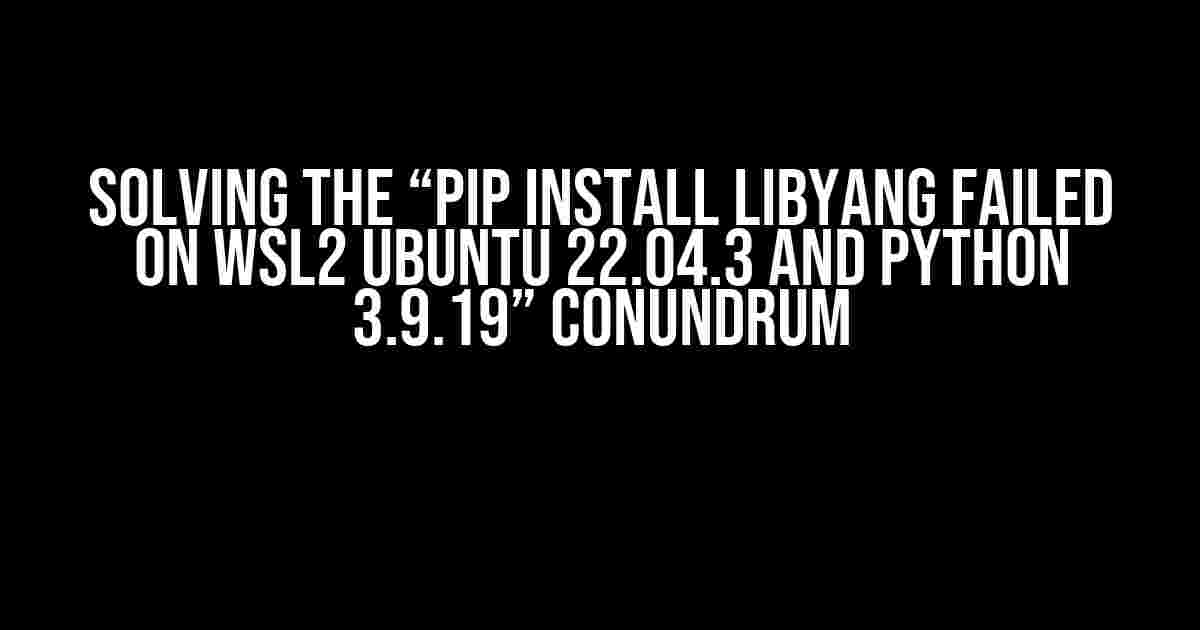Are you tired of encountering the frustrating “pip install libyang failed” error on your Windows Subsystem for Linux 2 (WSL2) Ubuntu 22.04.3 environment with Python 3.9.19? You’re not alone! In this comprehensive guide, we’ll delve into the root causes of this issue and provide a step-by-step solution to get libyang installed and working smoothly.
- Understanding the Error: What’s Going On?
- Prerequisites: Preparation is Key
- Step 1: Update and Upgrade Your WSL2 Environment
- Step 2: Install Essential Build Tools and Dependencies
- Step 3: Install libyang using pip
- Troubleshooting: Common Issues and Solutions
- Conclusion: libyang Installation Success!
- Final Thoughts
Understanding the Error: What’s Going On?
The error “pip install libyang failed” typically occurs due to one of the following reasons:
- Incompatible package versions
- Missing dependencies
- Insufficient permissions
- Corrupted package cache
In the context of WSL2 Ubuntu 22.04.3 and Python 3.9.19, the issue often stems from the lack of essential build tools and dependencies required for libyang installation.
Prerequisites: Preparation is Key
Before we dive into the solution, ensure you have the following prerequisites in place:
- WSL2 Ubuntu 22.04.3 installed and running on your Windows machine
- Python 3.9.19 installed and activated within your WSL2 environment
- A terminal or command prompt with administrative privileges
Step 1: Update and Upgrade Your WSL2 Environment
Initiate by updating and upgrading your WSL2 environment to ensure you have the latest package lists and dependencies:
sudo apt update && sudo apt full-upgrade -y
This command will update the package lists, upgrade existing packages, and remove any unnecessary dependencies.
Step 2: Install Essential Build Tools and Dependencies
Next, install the necessary build tools and dependencies required for libyang installation:
sudo apt install -y build-essential libssl-dev libxml2-dev libxslt-dev zlib1g-dev
This command will install the following essential packages:
- build-essential: Provides the necessary build tools and compilers
- libssl-dev: Required for SSL/TLS support in libyang
- libxml2-dev: Needed for XML parsing and validation
- libxslt-dev: Required for XSLT transformations
- zlib1g-dev: Provides compression and decompression capabilities
Step 3: Install libyang using pip
Now that you’ve installed the necessary dependencies, you can attempt to install libyang using pip:
pip install libyang
If you encounter any issues during this step, you can try reinstalling libyang with the following command:
pip uninstall libyang && pip install libyang
Troubleshooting: Common Issues and Solutions
If you’re still facing issues with the installation process, refer to the following troubleshooting section:
| Error Message | Solution |
|---|---|
| ‘libyang’ not found or ‘import libyang’ fails | Verify that you’ve installed libyang successfully using pip. If not, retry the installation process. |
| Permission denied errors | Run the installation commands with administrative privileges using ‘sudo’. |
| Corrupted package cache | Clear the package cache using ‘pip cache clean’ and retry the installation process. |
| Dependency issues | Verify that you’ve installed all the necessary dependencies listed in Step 2. |
Conclusion: libyang Installation Success!
By following this comprehensive guide, you should have successfully installed libyang on your WSL2 Ubuntu 22.04.3 environment with Python 3.9.19. If you encounter any further issues, feel free to explore additional resources or seek support from the libyang community.
Remember, troubleshooting is an essential part of the development process. Don’t be discouraged by errors – they’re an opportunity to learn and grow. Happy coding!
Bonus Tips and Variations
If you’re working with a virtual environment, make sure to activate it before installing libyang. Additionally, you can install libyang using other package managers like apt or conda, depending on your specific requirements.
# Install libyang using apt sudo apt install python3-libyang # Install libyang using conda conda install -c conda-forge libyang
Explore these alternative installation methods to find the one that best suits your needs.
Final Thoughts
In conclusion, the “pip install libyang failed on WSL2 Ubuntu 22.04.3 and Python 3.9.19” error can be resolved by following the steps outlined in this article. Remember to update and upgrade your WSL2 environment, install essential build tools and dependencies, and troubleshoot common issues. With patience and persistence, you’ll have libyang up and running in no time.
Frequently Asked Question
Are you stuck with the frustrating error when trying to install libyang using pip on WSL2 Ubuntu 22.04.3 with Python 3.9.19? Don’t worry, we’ve got you covered! Check out our FAQs below to find a solution that works for you.
Why does pip install libyang fail on WSL2 Ubuntu 22.04.3 with Python 3.9.19?
The error occurs due to missing dependencies, specifically the libyang development package, which is required for building the libyang Python module. You can easily resolve this by installing the necessary dependencies before running the pip install command.
How do I install the required dependencies for libyang on WSL2 Ubuntu 22.04.3?
Before installing libyang using pip, run the command sudo apt-get install libyang-dev to install the libyang development package. This should fix the dependency issue and allow you to successfully install libyang.
What is the correct command to install libyang using pip on WSL2 Ubuntu 22.04.3 with Python 3.9.19?
After installing the required dependencies, run the command pip3 install --no-cache-dir libyang to install libyang. The --no-cache-dir flag is important to avoid any caching issues that might occur.
What if I encounter permission issues while installing libyang using pip on WSL2 Ubuntu 22.04.3?
Run the command sudo pip3 install --no-cache-dir libyang instead. This will install libyang with elevated privileges, resolving any permission issues that might arise.
Is there a way to verify that libyang has been successfully installed on WSL2 Ubuntu 22.04.3 with Python 3.9.19?
After installing libyang, open a new Python terminal or shell and run the command python -c "import libyang; print(libyang.__version__)". If libyang is installed correctly, this should print the version of libyang. If not, try reinstalling libyang following the steps above.

